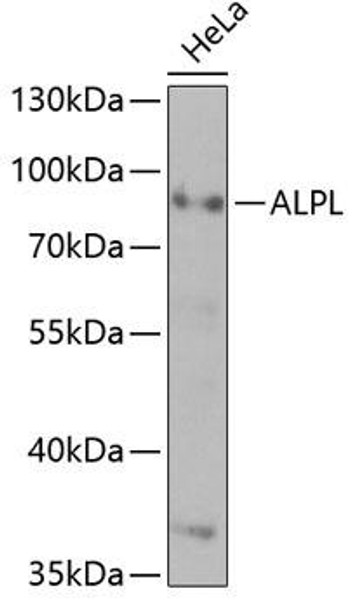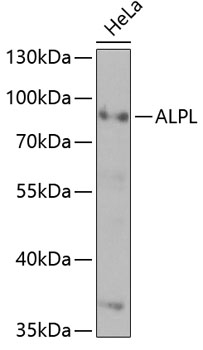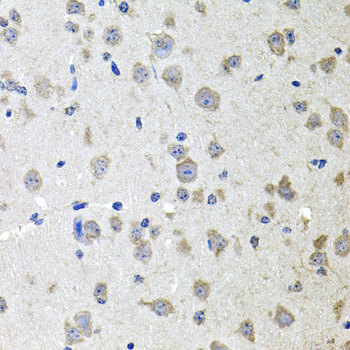Anti-ALPL Antibody (CAB1080)
- SKU:
- CAB1080
- Product type:
- Antibody
- Reactivity:
- Human
- Reactivity:
- Mouse
- Host Species:
- Rabbit
- Isotype:
- IgG
- Antibody Type:
- Polyclonal Antibody
- Research Area:
- Signal Transduction
Description
| 抗体名: | Anti-ALPL Antibody |
| 抗体コード: | CAB1080 |
| 抗体サイズ: | 20uL, 50uL, 100uL |
| 申し込み: | WB IHC |
| 反応性: | Human, Mouse |
| 宿主種: | Rabbit |
| 免疫原: | Recombinant fusion protein containing a sequence corresponding to amino acids 20-270 of human ALPL (NP_000469.3). |
| 申し込み: | WB IHC |
| 推奨希釈: | WB 1:500 - 1:2000 IHC 1:50 - 1:200 |
| 反応性: | Human, Mouse |
| ポジティブサンプル: | HeLa |
| 免疫原: | Recombinant fusion protein containing a sequence corresponding to amino acids 20-270 of human ALPL (NP_000469.3). |
| 精製方法: | Affinity purification |
| ストレージバッファ: | Store at -20'C. Avoid freeze / thaw cycles. Buffer: PBS with 0.02% sodium azide, 50% glycerol, pH7.3. |
| アイソタイプ: | IgG |
| 順序: | PEKE KDPK YWRD QAQE TLKY ALEL QKLN TNVA KNVI MFLG DGMG VSTV TAAR ILKG QLHH NPGE ETRL EMDK FPFV ALSK TYNT NAQV PDSA GTAT AYLC GVKA NEGT VGVS AATE RSRC NTTQ GNEV TSIL RWAK DAGK SVGI VTTT RVNH ATPS AAYA HSAD RDWY SDNE MPPE ALSQ GCKD IAYQ LMHN IRDI DVIM GGGR KYMY PKNK TDVE YESD EKAR GTRL DGLD LVDT WKSF KPRY KHSH FIW |
| 遺伝子ID: | 249 |
| Uniprot: | P05186 |
| セルラーロケーション: | Cell membrane, GPI-anchor, Lipid-anchor |
| 計算された分子量: | 48kDa/51kDa/57kDa |
| 観察された分子量: | 88kDa |
| 同義語: | ALPL, AP-TNAP, APTNAP, HOPS, TNAP |
| バックグラウンド: | This gene encodes a member of the alkaline phosphatase family of proteins. There are at least four distinct but related alkaline phosphatases: intestinal, placental, placental-like, and liver/bone/kidney (tissue non-specific). The first three are located together on chromosome 2, while the tissue non-specific form is located on chromosome 1. The product of this gene is a membrane bound glycosylated enzyme that is not expressed in any particular tissue and is, therefore, referred to as the tissue-nonspecific form of the enzyme. Alternative splicing results in multiple transcript variants, at least one of which encodes a preproprotein that is proteolytically processed to generate the mature enzyme. This enzyme may play a role in bone mineralization. Mutations in this gene have been linked to hypophosphatasia, a disorder that is characterized by hypercalcemia and skeletal defects. |
| UniProt Protein Function: | ALPL: This isozyme may play a role in skeletal mineralization. Defects in ALPL are a cause of hypophosphatasia (HOPS). HOPS is an inherited metabolic bone disease characterized by defective skeletal mineralization. Four hypophosphatasia forms are distinguished, depending on the age of onset: perinatal, infantile, childhood and adult type. The perinatal form is the most severe and is almost always fatal. Patients with only premature loss of deciduous teeth, but with no bone disease are regarded as having odontohypophosphatasia (odonto). Defects in ALPL are a cause of hypophosphatasia childhood type (HOPSC). Defects in ALPL are a cause of hypophosphatasia infantile type (HOPSI). Belongs to the alkaline phosphatase family. 3 isoforms of the human protein are produced by alternative splicing. |
| UniProt Protein Details: | Protein type:EC 3.1.3.1; Cofactor and Vitamin Metabolism - folate biosynthesis; Membrane protein, GPI anchor; Motility/polarity/chemotaxis; Phosphatase (non-protein) Chromosomal Location of Human Ortholog: 1p36.12 Cellular Component: extracellular matrix; extracellular space; membrane; integral to membrane; plasma membrane Molecular Function:protein binding; pyrophosphatase activity; alkaline phosphatase activity; metal ion binding Biological Process: osteoblast differentiation; response to antibiotic; response to vitamin D; dephosphorylation; response to glucocorticoid stimulus; reproductive developmental process; response to lipopolysaccharide; skeletal development; endochondral ossification Disease: Hypophosphatasia, Infantile; Hypophosphatasia, Adult; Hypophosphatasia, Childhood |
| NCBI Summary: | There are at least four distinct but related alkaline phosphatases: intestinal, placental, placental-like, and liver/bone/kidney (tissue non-specific). The first three are located together on chromosome 2, while the tissue non-specific form is located on chromosome 1. The product of this gene is a membrane bound glycosylated enzyme that is not expressed in any particular tissue and is, therefore, referred to as the tissue-nonspecific form of the enzyme. The exact physiological function of the alkaline phosphatases is not known. A proposed function of this form of the enzyme is matrix mineralization; however, mice that lack a functional form of this enzyme show normal skeletal development. This enzyme has been linked directly to hypophosphatasia, a disorder that is characterized by hypercalcemia and includes skeletal defects. The character of this disorder can vary, however, depending on the specific mutation since this determines age of onset and severity of symptoms. Alternatively spliced transcript variants have been described. [provided by RefSeq, Apr 2010] |
| UniProt Code: | P05186 |
| NCBI GenInfo Identifier: | 68067533 |
| NCBI Gene ID: | 249 |
| NCBI Accession: | P05186.4 |
| UniProt Secondary Accession: | P05186,O75090, Q2TAI7, Q59EJ7, Q5BKZ5, Q5VTG5, Q6NZI8 Q8WU32, A1A4E7, B2RMP8, B7Z387, B7Z4Y6, |
| UniProt Related Accession: | P05186 |
| Molecular Weight: | 51,045 Da |
| NCBI Full Name: | Alkaline phosphatase, tissue-nonspecific isozyme |
| NCBI Synonym Full Names: | alkaline phosphatase, liver/bone/kidney |
| NCBI Official Symbol: | ALPL |
| NCBI Official Synonym Symbols: | HOPS; TNAP; APTNAP; TNSALP; AP-TNAP |
| NCBI Protein Information: | alkaline phosphatase, tissue-nonspecific isozyme; glycerophosphatase; tissue-nonspecific ALP; alkaline phosphomonoesterase; liver/bone/kidney-type alkaline phosphatase; alkaline phosphatase liver/bone/kidney isozyme |
| UniProt Protein Name: | Alkaline phosphatase, tissue-nonspecific isozyme |
| UniProt Synonym Protein Names: | Alkaline phosphatase liver/bone/kidney isozyme |
| Protein Family: | Alkaline phosphatase |
| UniProt Gene Name: | ALPL |
| UniProt Entry Name: | PPBT_HUMAN |



